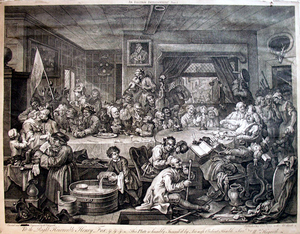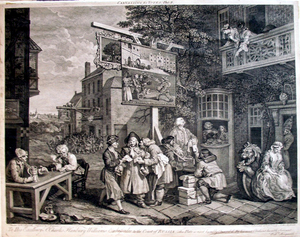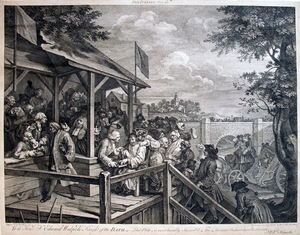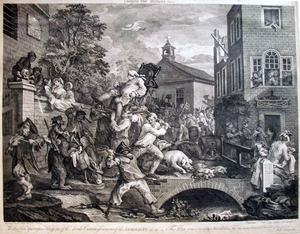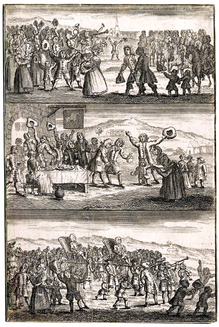William Hogarth (1697-1764), Four Prints of an Election, 1755-58. Graphic Arts, GC113 William Hogarth Collection
Plate I: An Election Entertainment, February 1755. Fourth state.
The Whigs are inside with a banner inscribed ‘Liberty and Loyalty’ and the Tories are parading outside with their own banner ‘Liberty and Property.’ Hogarth does not take sides. The print is dedicated to Henry Fox (Baron Holland 1705-1775), who was the first person to pay his money for the print. The man by the bottle of Burgundy, making a face with his napkin, is Sir John Parnell, nephew of the poet Thomas Parnell, who persuaded Hogarth to include him by arguing that it would help sell copies in Dublin.
Plate II: Canvassing for Votes, 1758? Sixth state.
Here the Tories are in the foreground and the Whigs in the background. The man in the middle is being bribed by each party. The ale house at the left is the [Por]tobello, named after the British naval victory over the French. Paulson suggests that Hogarth wants our sympathies to be with the pair at the table, reliving a heroic memory, and not with the politicians across the way.
Plate III: The Polling, February 1758. Third state.
Here is a polling booth on election day. All classes of men are being led up to cast a vote, described as an imbecile, a prisoner, and so on. Britannia is seen in her coach on the right, about to turn over because her coachmen are playing cards. All the nation’s efforts are directed to bribery and gambling, rather than for the good of the people.
Plate IV: Chairing the Members. January 1758. Third state.
Hogarth has the winners being carried on chairs but in fact, there was no “chairing” of the Oxfordshire election since the results were immediately referred to Parliament for scrutiny. The central man who is about to fall off his chair is George Bubb Dodington, the only prominent politician who went down to defeat in the election.
It has been suggested that Hogarth’s Election series was inspired by the frontispiece to The Humours of a Country Election (London: printed for J. Roberts, 1734), seen on the left. The Oxfordshire election of 1754 might have been inspiration enough, with its unprecedented levels of bribery and corruption. In any case, the series was a tremendous success. David Bindman writes “Hogarth’s Election paintings and the prints he made after them are the most sustained achievement of the artist’s later years.”
These notes come from: Hogarth’s Graphic Works, compiled and with a commentary by Ronald Paulson. 3rd rev. ed. London: Print Room, 1989. Graphic Arts: Reference Collection (GARF) Oversize ND497.H7 A35 1989q
